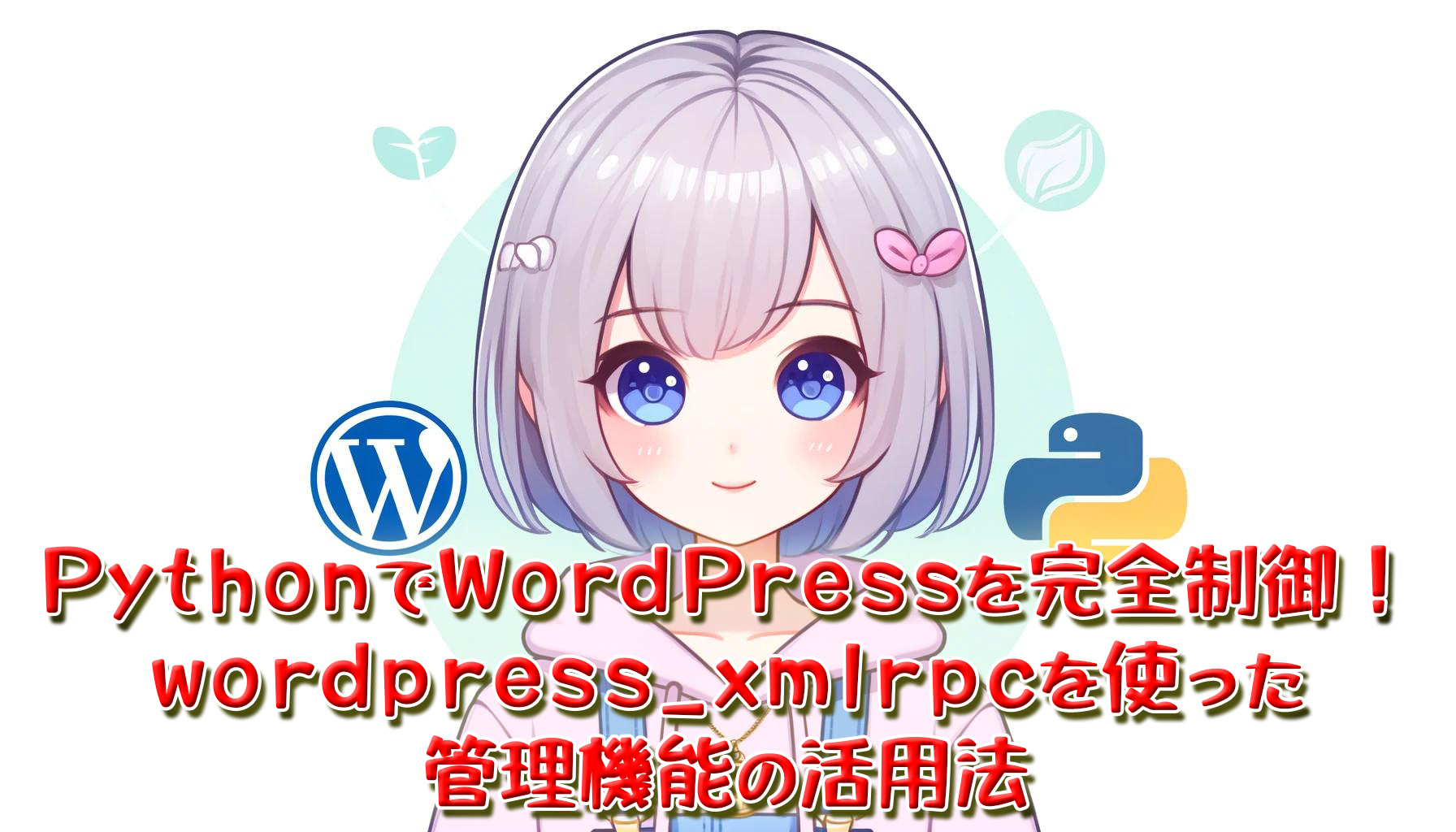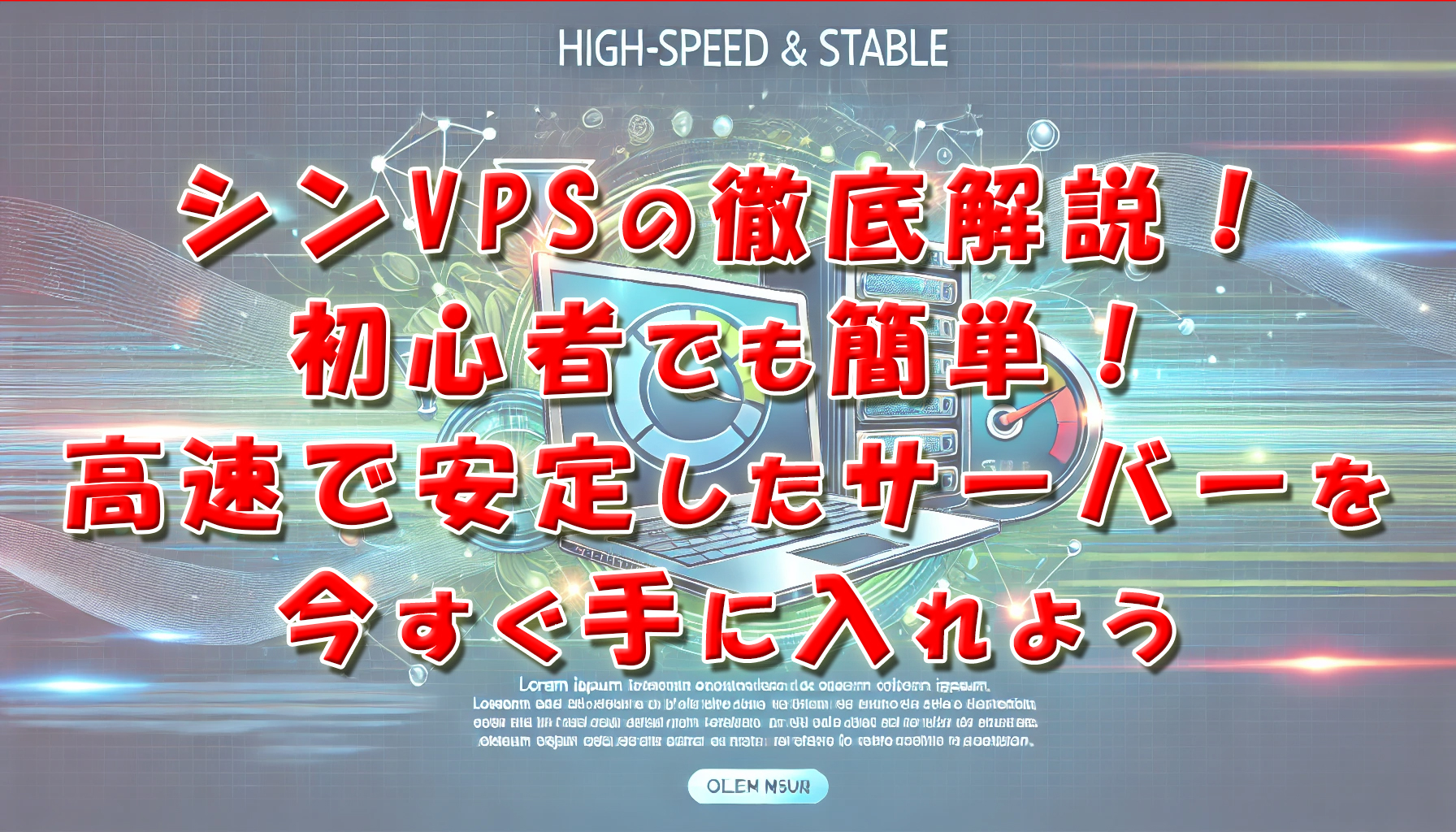Pythonを使って、WordPressの管理を効率化する方法があります。それがwordpress_xmlrpcライブラリです。このライブラリを使用することで、Pythonから直接WordPressを操作し、記事の投稿、編集、削除、コメントの管理、メディアのアップロード、ユーザー管理などを自動化することができます。本記事では、wordpress_xmlrpcを使ったさまざまな管理機能の活用方法について、実践的なコード例を交えて解説します。
wordpress_xmlrpcとは?
wordpress_xmlrpcは、WordPressのXML-RPC APIを操作するためのPythonライブラリです。XML-RPCは、WordPressの管理画面やREST APIとは異なるインターフェースで、記事の作成・編集、コメントの管理、メディアファイルのアップロード、ユーザーの操作などが可能です。PythonでWordPressを制御するために必要なライブラリで、WordPressの管理作業を効率化し、サイト運営を支援します。
wordpress_xmlrpcを使った記事の管理
wordpress_xmlrpcを使うことで、WordPressに投稿された記事の作成、編集、削除をプログラムから簡単に行うことができます。次に、具体的な操作方法を見ていきましょう。
記事の投稿
WordPressに記事を投稿するには、WordPressPostクラスを使って投稿オブジェクトを作成し、それをNewPostメソッドでWordPressに送信します。
from wordpress_xmlrpc import Client, WordPressPost
from wordpress_xmlrpc.methods import posts
# WordPressの設定
wordpress_url = 'https://your-wordpress-site.com/xmlrpc.php'
username = 'your_username'
password = 'your_password'
# クライアントの設定
client = Client(wordpress_url, username, password)
# 新しい記事の作成
post = WordPressPost()
post.title = 'Pythonで投稿した記事'
post.content = 'この投稿はPythonを使って自動で作成されたものです。'
post.post_status = 'publish' # 公開
# 記事を投稿
client.call(posts.NewPost(post))
print("記事が投稿されました。")記事の編集
既存の記事を編集する場合は、GetPostメソッドで投稿を取得し、その内容を変更してからEditPostメソッドで更新します。
from wordpress_xmlrpc.methods import posts
# 編集する記事のID
post_id = 1 # 編集したい記事のID
# 記事の取得と編集
post = client.call(posts.GetPost(post_id))
post.title = '編集されたタイトル'
post.content = '編集された内容です。'
# 記事を更新
client.call(posts.EditPost(post.id, post))
print("記事が編集されました。")記事の削除
記事を削除する場合は、DeletePostメソッドを使って指定したIDの記事を削除します。
from wordpress_xmlrpc.methods import posts
# 削除する記事のID
post_id = 1 # 削除したい記事のID
# 記事を削除
client.call(posts.DeletePost(post_id))
print("記事が削除されました。")記事の一覧取得
サイトに投稿されている記事を一覧で取得することもできます。これにより、管理画面で記事を手動で確認せずに、Pythonから記事の情報を取得できます。
from wordpress_xmlrpc.methods import posts
# 記事一覧を取得
posts_list = client.call(posts.GetPosts({'number': 100}))
for post in posts_list:
print(f"タイトル: {post.title}, 公開日: {post.date}, ステータス: {post.post_status}")コメントの管理
wordpress_xmlrpcでは、記事に対するコメントの管理も可能です。コメントを取得、承認、削除することができます。
コメントの取得
特定の記事に対するコメントを取得することができます。
from wordpress_xmlrpc.methods import comments
# 記事に対するコメントを取得
comments_list = client.call(comments.GetComments(post_id=1))
for comment in comments_list:
print(f"コメント者: {comment.author}, コメント: {comment.content}")コメントの承認
コメントを承認するには、ApproveCommentメソッドを使用します。
from wordpress_xmlrpc.methods import comments
# コメントを承認
comment_id = 1 # 承認するコメントのID
client.call(comments.ApproveComment(comment_id))
print("コメントが承認されました。")メディアのアップロード
wordpress_xmlrpcを使えば、PythonからWordPressにメディアファイルをアップロードすることも可能です。
from wordpress_xmlrpc import Client, WordPressMedia
from wordpress_xmlrpc.methods import media
from wordpress_xmlrpc.compat import xmlrpc_client
# メディアファイルをアップロード
media_file_path = 'path_to_your_image.jpg'
with open(media_file_path, 'rb') as img:
data = {
'name': 'image.jpg',
'type': 'image/jpeg',
'bits': xmlrpc_client.Binary(img.read())
}
media_object = WordPressMedia(data)
response = client.call(media.UploadFile(media_object))
print(f"アップロードされたメディアのURL: {response['url']}")ユーザーの管理
WordPressに新しいユーザーを追加したり、既存のユーザー情報を取得したりすることもできます。
from wordpress_xmlrpc.methods import users
# 新しいユーザーの作成
new_user = {
'username': 'newuser',
'password': 'newpassword',
'email': 'newuser@example.com',
'role': 'subscriber' # 権限(管理者、編集者、購読者など)
}
client.call(users.NewUser(new_user))
print("新しいユーザーが作成されました。")カテゴリー、タグ、カスタムフィールドの管理
wordpress_xmlrpcを使うと、カテゴリーやタグの追加・管理、カスタムフィールドの設定も可能です。
カテゴリーの追加
from wordpress_xmlrpc.methods import taxonomies
new_category = {
'name': '新しいカテゴリー',
'slug': 'new-category',
'taxonomy': 'category'
}
client.call(taxonomies.NewTerm(new_category))
print("新しいカテゴリーが作成されました。")タグの追加
from wordpress_xmlrpc.methods import taxonomies
new_tag = {
'name': '新しいタグ',
'slug': 'new-tag',
'taxonomy': 'post_tag'
}
client.call(taxonomies.NewTerm(new_tag))
print("新しいタグが作成されました。")カスタムフィールドの設定
from wordpress_xmlrpc.methods import posts
post_id = 1 # 変更したい記事のID
post = client.call(posts.GetPost(post_id))
post.custom_fields = {'custom_field_name': 'value'}
client.call(posts.EditPost(post.id, post))
print("カスタムフィールドが設定されました。")メニューの管理
WordPressでは、ナビゲーションメニューを管理できます。wordpress_xmlrpcを使ってメニュー項目の追加・削除ができます。
メニュー項目の追加
from wordpress_xmlrpc.methods import menus
# メニューに追加する項目のデータ
new_menu_item = {
'title': '新しいメニュー項目',
'url': 'https://your-wordpress-site.com/new-page',
'menu': 'primary-menu' # メニュー名
}
# メニュー項目を追加
client.call(menus.AddMenuItem(new_menu_item))
print("メニュー項目が追加されました。")サイト情報の管理
wordpress_xmlrpcを使用して、サイトの基本情報を取得したり、設定を変更したりすることができます。
サイト情報の取得
from wordpress_xmlrpc.methods import options
# サイトの基本情報を取得
site_info = client.call(options.GetOptions())
print(f"サイトタイトル: {site_info['blogname']}")
print(f"サイトの説明: {site_info['blogdescription']}")テーマの管理
wordpress_xmlrpc自体は、テーマの管理を直接行うAPIは提供していませんが、現在使用しているテーマの情報を取得することはできます。
現在使用しているテーマの取得
from wordpress_xmlrpc.methods import options
# 現在使用しているテーマを取得
site_info = client.call(options.GetOptions())
print(f"現在使用しているテーマ: {site_info['theme']}")プラグインの管理
プラグインのインストールや削除は直接的に操作できませんが、インストールされているプラグインの情報を取得したり、有効化・無効化することはできます。
プラグインの一覧取得
from wordpress_xmlrpc.methods import plugins
# プラグインの一覧を取得
plugins_list = client.call(plugins.GetPlugins())
for plugin in plugins_list:
print(f"プラグイン名: {plugin['name']}, 状態: {plugin['status']}")プラグインの有効化
from wordpress_xmlrpc.methods import plugins
# プラグインを有効化
plugin_slug = 'plugin-slug'
client.call(plugins.ActivatePlugin(plugin_slug))
print(f"{plugin_slug} プラグインが有効化されました。")バックアップ
wordpress_xmlrpcは直接的にバックアップ機能を提供していませんが、記事やメディアをエクスポートすることはできます。
記事のエクスポート
from wordpress_xmlrpc.methods import posts
# 記事をエクスポートするために取得
posts_list = client.call(posts.GetPosts({'number': 100}))
# XML形式などにエクスポートする場合、手動でファイルに書き出すことができます
with open('backup_posts.xml', 'w') as f:
for post in posts_list:
f.write(f"<post>\n<title>{post.title}</title>\n<content>{post.content}</content>\n</post>\n")
print("投稿がバックアップされました。")管理者操作の自動化
wordpress_xmlrpcを使って、管理者操作を自動化することができます。例えば、定期的に記事を公開したり、コメントを承認したりすることができます。
定期的な記事の投稿
import schedule
import time
def post_article():
post = WordPressPost()
post.title = '定期的な投稿'
post.content = 'これは定期的に投稿される記事です。'
post.post_status = 'publish'
client.call(posts.NewPost(post))
print("定期的に記事が投稿されました。")
# 1時間ごとに記事を投稿
schedule.every(1).hour.do(post_article)
while True:
schedule.run_pending()
time.sleep(1)まとめ
wordpress_xmlrpcを使うことで、PythonからWordPressのさまざまな管理機能を効率的に操作できます。記事の投稿、編集、削除、コメントの管理、メディアファイルのアップロード、ユーザー管理、カテゴリー・タグの操作、テーマやプラグインの管理など、幅広い機能を自動化することが可能です。また、サイト情報の取得やバックアップの一部もサポートしており、WordPressの運営を大幅に効率化できます。
これらの機能を活用することで、WordPressの管理作業を自動化し、手動で行っていた作業の負担を軽減することができます。さらに、定期的な操作や大量のデータを処理する必要がある場合にも、wordpress_xmlrpcは非常に便利なツールとなります。サイト運営をよりスムーズに、効果的に行うために、このライブラリを活用しましょう。





コメント